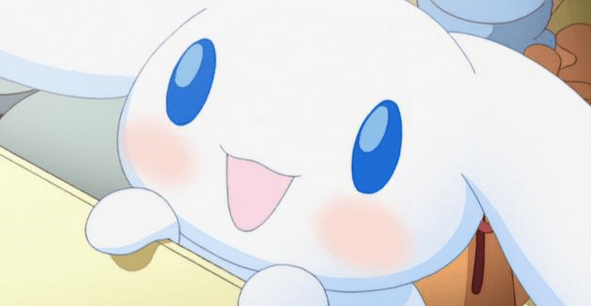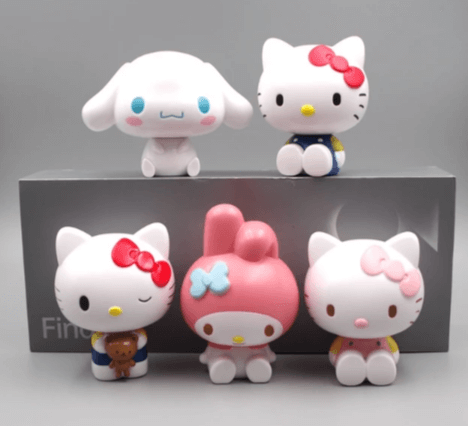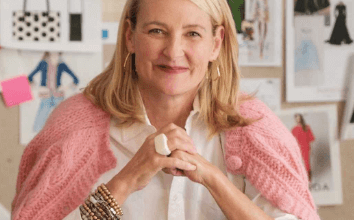cinnamoroll:emjaq6vqzvm= kuromi:fox5ydxdt58= hello kitty

Introduction
Cinnamoroll, Kuromi, and Hello Kitty are three beloved characters from the Sanrio universe, each with a unique charm and global fan base. Cinnamoroll is known for his fluffy, cloud-like appearance and sweet personality, while cinnamoroll:emjaq6vqzvm= kuromi:fox5ydxdt58= hello kitty stands out with her punk-rock aesthetic and mischievous nature. Hello Kitty remains an iconic figure, symbolizing innocence and friendship. This article explores their histories, cultural impacts, and what the future holds for these beloved characters.
The Origins of Cinnamoroll
Cinnamoroll was introduced by Sanrio in 2002 and quickly became a favorite among fans. Created by Miyuki Okumura, Cinnamoroll is a white puppy with long ears that enable him to fly. He was named after his cinnamon roll-like tail, which adds to his endearing appearance. Cinnamoroll’s backstory involves him being discovered by a café owner and becoming the café’s mascot, charming customers with his adorable looks and sweet demeanor.
Cinnamoroll’s Character Design and Personality
Cinnamoroll’s design is characterized by his fluffy, white fur and big, blue eyes. His long ears are not just for show—they allow him to fly, adding a magical element to his character. Personality-wise, Cinnamoroll is friendly, shy, and always eager to help others. His gentle and kind-hearted nature makes him a beloved character among Sanrio fans of all ages.
Cinnamoroll in Sanrio Universe
Within the Sanrio universe, Cinnamoroll plays the role of a lovable and helpful friend. His interactions with other Sanrio characters often highlight his kind nature and his willingness to lend a hand. Cinnamoroll’s popularity has led to numerous appearances in various media, merchandise, and themed events, solidifying his place as a key member of the Sanrio family.
The Origins of Kuromi
Kuromi was introduced in 2005 as a counterpart and rival to My Melody. Created by Matsubayashi Atsuko, Kuromi’s distinctive punk-rock style and mischievous personality quickly made her a fan favorite. She wears a black jester’s hat adorned with a pink skull and has a devilish grin, symbolizing her rebellious spirit. Kuromi’s creation added a darker, edgier character to the Sanrio lineup, appealing to fans who appreciate a character with a bit of an edge.

Kuromi’s Character Design and Personality
Kuromi’s design is both cute and edgy. Her black jester’s hat with a pink skull is iconic, and her devilish grin sets her apart from other Sanrio characters. Despite her tough exterior, Kuromi has a softer side, enjoying activities like writing in her diary and dreaming about her crush. This combination of rebelliousness and vulnerability makes her a relatable and multifaceted character.
Read Also kuromi:fox5ydxdt58= sanrio:alu4_8z-yr8= hello kitty
Kuromi’s Role in Sanrio Universe
Kuromi often plays the role of an antagonist, particularly to My Melody, but she is also a beloved character in her own right. Her dynamic interactions with other characters and her standalone appeal highlight Sanrio’s ability to create characters that resonate across different themes and styles. Kuromi’s popularity has led to numerous appearances in various media and merchandise.
Hello Kitty: A Global Icon
Hello Kitty, created by Yuko Shimizu and introduced in 1974, is Sanrio’s most iconic character. With her simple design—a white cat with a red bow—Hello Kitty represents innocence, friendship, and universal appeal. Over the years, she has become a global icon, with her image appearing on a wide range of products, from toys and clothing to home decor and electronics.
Hello Kitty’s Design and Personality
Hello Kitty’s design is minimalistic yet instantly recognizable. She has no mouth, which Sanrio explains allows her to speak from the heart. Her personality is gentle, kind, and always ready to help a friend. These traits have made her a beloved figure worldwide, symbolizing universal values of love and friendship.
Hello Kitty in Media and Pop Culture
Hello Kitty has appeared in numerous TV shows, movies, and other media forms. These appearances often emphasize themes of friendship and adventure, reinforcing her positive and uplifting character. Beyond media, Hello Kitty’s image is ubiquitous in fashion, toys, and even household items, demonstrating her vast influence on pop culture.
Merchandise and Collectibles
Merchandise plays a significant role in the popularity of Cinnamoroll, Kuromi, and Hello Kitty. Cinnamoroll’s products often feature his fluffy and cute design, including plush toys, stationery, and accessories. Kuromi’s punk-rock style is featured on various products, including apparel and accessories. Hello Kitty’s extensive product range covers everything from stationery and clothing to home decor and tech gadgets. These collectibles are highly sought after by fans and collectors alike.
Fan Communities and Fandoms
The fan communities dedicated to Cinnamoroll, Kuromi, and Hello Kitty are vibrant and active. These fandoms share a passion for their favorite characters through fan art, cosplay, and online discussions. Social media platforms and fan conventions provide spaces for fans to connect, share their creations, and celebrate their shared interests.
Cinnamoroll’s Cultural Impact
Cinnamoroll has had a significant cultural impact, especially in the realms of cuteness and charm. His sweet and gentle personality has inspired various artistic expressions and merchandise. Cinnamoroll’s appeal lies in his ability to resonate with those who value kindness and gentle charm, making him a cultural icon in his own right.
Kuromi’s Cultural Impact
Kuromi has made a significant impact on pop culture, particularly among fans of alternative fashion and gothic aesthetics. Her unique look and personality have inspired countless fan artworks, cosplay, and even fashion trends. Kuromi’s appeal lies in her ability to resonate with those who value individuality and nonconformity, making her a cultural icon in her own right.
Hello Kitty’s Global Reach
Hello Kitty’s appeal is truly global, with fans from all corners of the world. Her image is recognized universally, making her a powerful symbol of Japanese pop culture. Hello Kitty has appeared in various international collaborations, from fashion brands to food products, further cementing her status as a cultural icon. Her global reach is a testament to her enduring charm and the effectiveness of Sanrio’s marketing strategies.
Sanrio Characters in Collaboration
Sanrio often collaborates with other brands to create unique products featuring Cinnamoroll, Kuromi, and Hello Kitty. These collaborations highlight their unique characteristics while celebrating their shared Sanrio heritage. From limited-edition merchandise to themed events, these projects attract fans of all characters and showcase the versatility of Sanrio’s creations.
Comparing Cinnamoroll, Kuromi, and Hello Kitty
While Cinnamoroll, Kuromi, and Hello Kitty are all part of the Sanrio family, they represent different facets of the brand. Cinnamoroll’s gentle charm contrasts with Kuromi’s rebellious spirit, while Hello Kitty’s universal appeal bridges the gap between them. This comparison highlights the diversity within Sanrio’s character lineup and the different ways these characters resonate with their fans.
The Evolution of Sanrio Characters
Sanrio characters, including Cinnamoroll, Kuromi, and Hello Kitty, have evolved over time to stay relevant to new generations. Changes in design, personality traits, and marketing strategies reflect broader cultural trends and consumer preferences. This evolution has allowed Sanrio to maintain its characters’ popularity and continue appealing to a diverse audience.
Future Prospects for Cinnamoroll, Kuromi, and Hello Kitty
The future looks promising for Cinnamoroll, Kuromi, and Hello Kitty. Sanrio continues to innovate with new products and media appearances, ensuring these characters remain fresh and exciting. Upcoming releases and collaborations are likely to introduce these beloved characters to new audiences and further cement their status as cultural icons.
FAQs about Cinnamoroll, Kuromi, and Hello Kitty
Where did Cinnamoroll originate? Cinnamoroll was created by Sanrio in 2002 and quickly became a favorite among fans for his fluffy, cloud-like appearance and sweet personality.
What is Kuromi’s backstory? Kuromi was introduced by Sanrio in 2005 as a rival to My Melody, known for her punk-rock style and mischievous nature.
How does Hello Kitty differ from Cinnamoroll and Kuromi? Hello Kitty embodies sweetness and innocence, while Cinnamoroll represents gentle charm, and Kuromi brings a rebellious and edgy persona.
What types of merchandise are available for Cinnamoroll, Kuromi, and Hello Kitty? Merchandise includes plush toys, apparel, accessories, stationery, and home decor, among other items.
How have Cinnamoroll and Kuromi influenced fashion? Cinnamoroll has inspired cute and gentle fashion trends, while Kuromi has influenced alternative and gothic styles.
What are some notable collaborations involving Cinnamoroll, Kuromi, and Hello Kitty? Collaborations include limited-edition merchandise and themed events that highlight their unique personalities and shared Sanrio heritage.
Conclusion
Cinnamoroll, Kuromi, and Hello Kitty each hold a special place in the world of Japanese pop culture. cinnamoroll:emjaq6vqzvm= kuromi:fox5ydxdt58= hello kitty rebellious spirit, and Hello Kitty’s universal appeal showcase the diversity and creativity of Sanrio’s creations. As these characters continue to evolve and inspire, their impact on fans and popular culture remains profound. The enduring legacy of Cinnamoroll, Kuromi, and Hello Kitty is a testament to their timeless appeal and the innovative spirit behind their creation.




